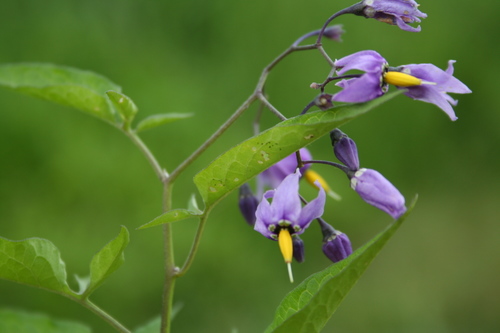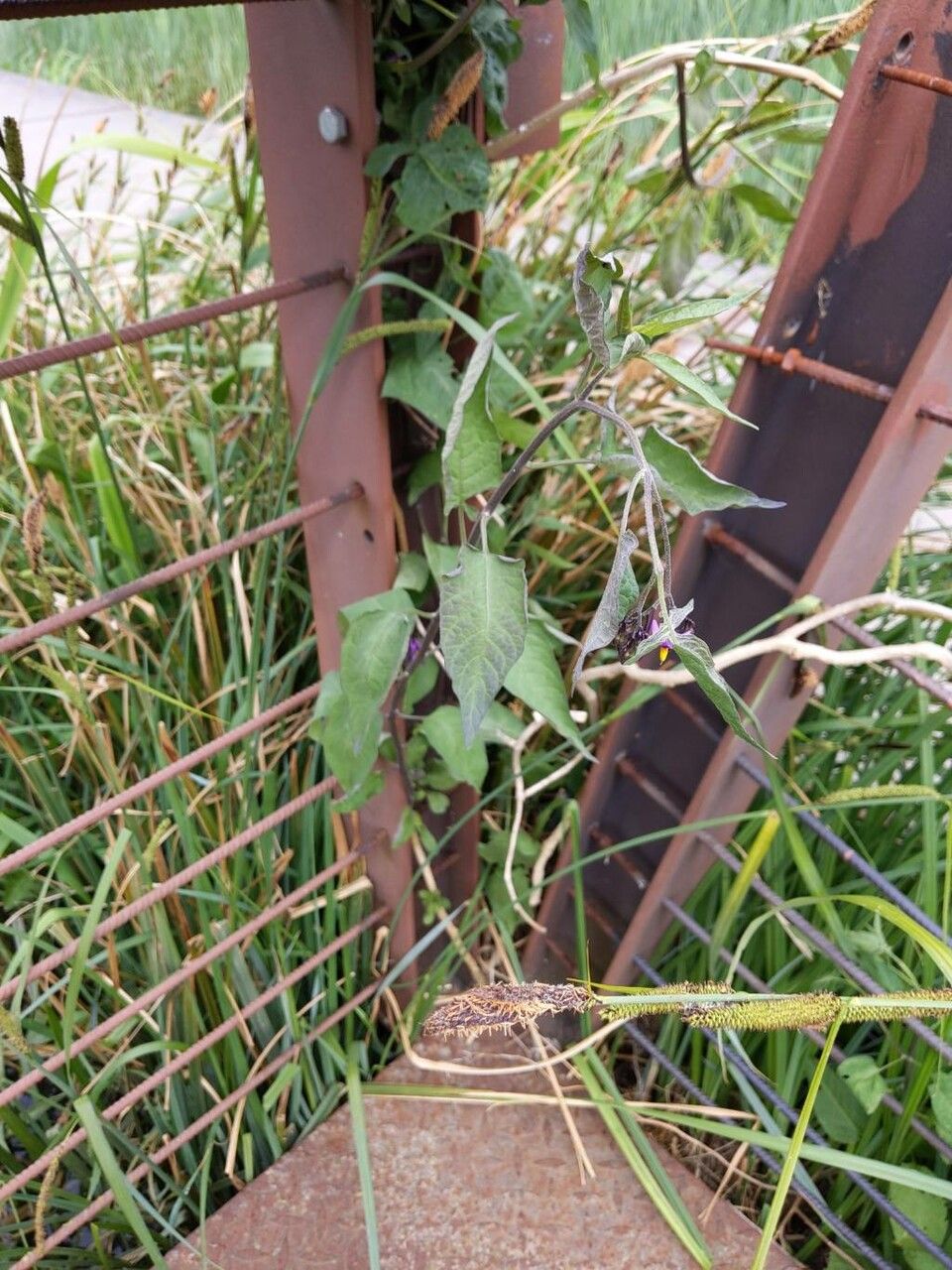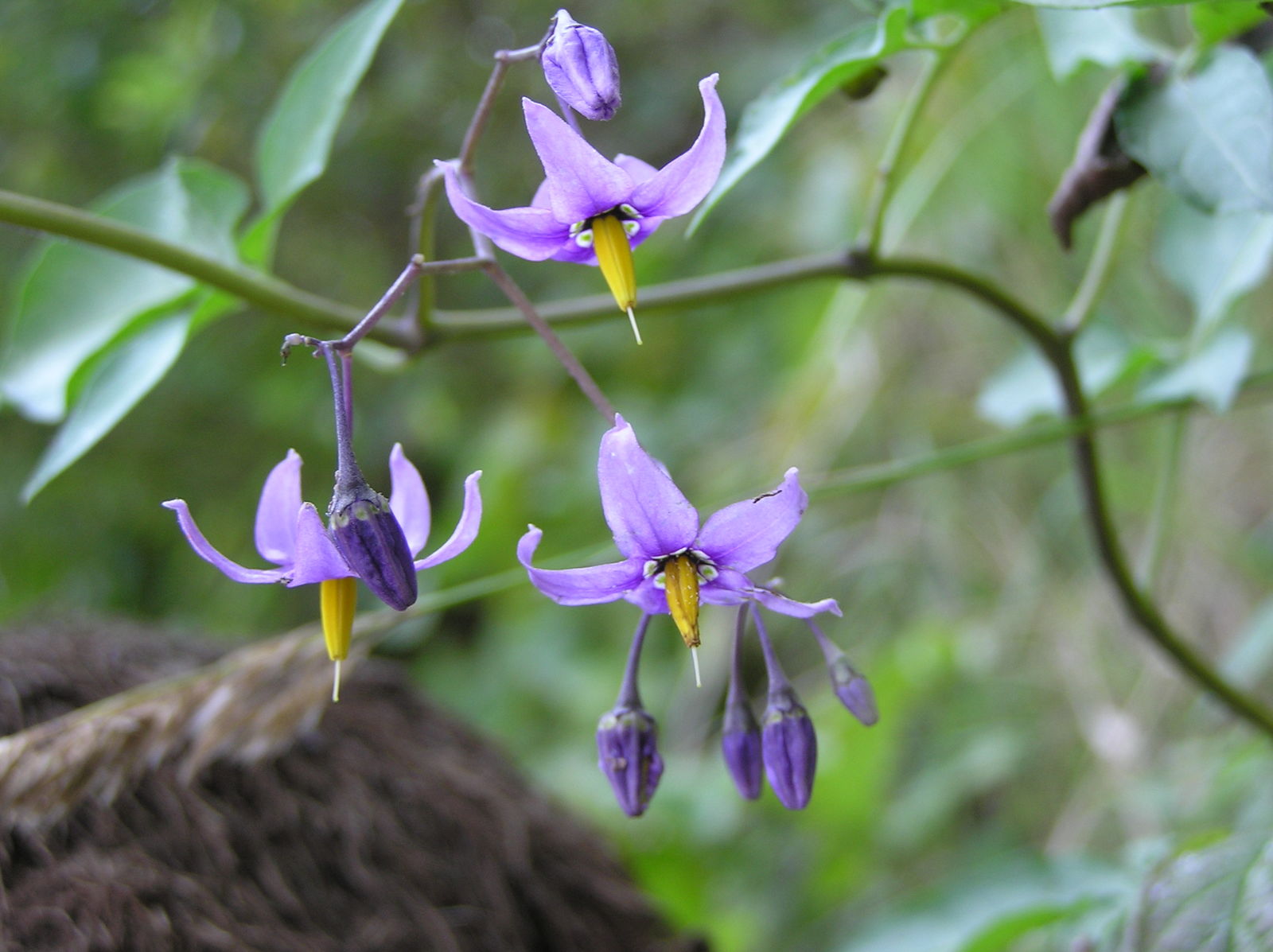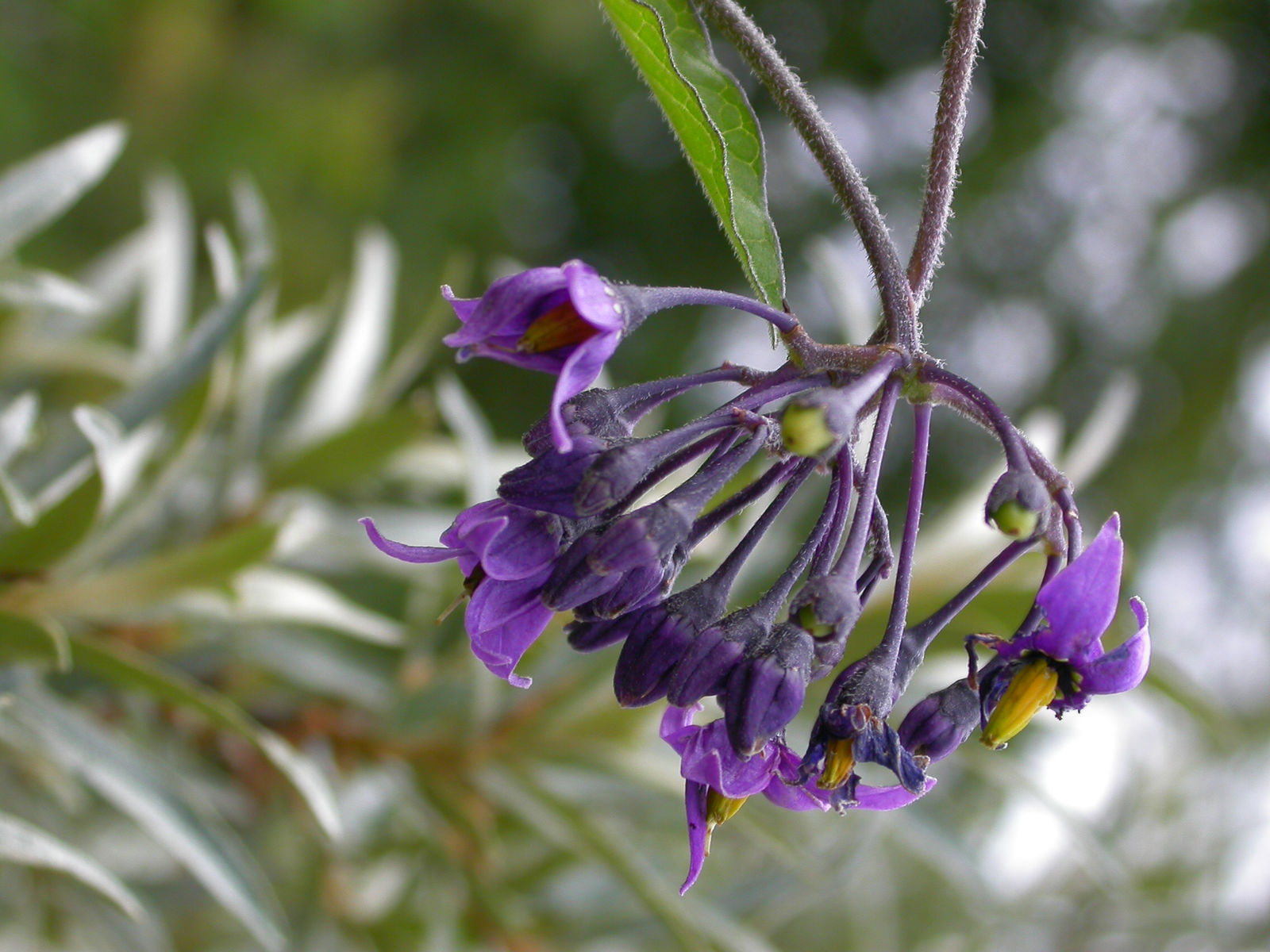Bittersweet Nightshade
solanum dulcamara
Also known as: ["Bittersweet","Fell Henbane","Twinberry"]
Overview
A woody, climbing or trailing perennial vine in the nightshade family, known for its purple flowers and bright red berries.
Benefits & Perks
["wildlife attractant (bees, butterflies, birds)","seasonal color change"]
Botanical Classification
| Phylum: | Magnoliophyta |
| Class: | Magnoliopsida |
| Order: | Solanales |
| Family: | Solanaceae |
| Genus: | Solanum |
| Botanical Name: | Solanum dulcamara |
Plant Characteristics
Basic Information
- Category: Flowers
- Suitable Location: garden border, trellis, or container with support
- Suitable For:
- Is Weed: No
- Allergenicity: moderate
Environmental Needs
- Climate: {"temperatureRange":"5–30°C"}
- Hardiness: {"zones":"4–8"}
- Misting: rarely required, only if ambient humidity is very low
- Drainage: Fast-draining to prevent waterlogging.
- Soil Type: Well-draining potting mix with added organic matter like compost or peat moss.
Maintenance Level
- Maintenance Level: moderate
- Toughness Level: moderate
- Pruning Frequency: Annually in late winter or early spring before new growth begins.
- Pruning Intensity: Moderate; remove up to one-third of the oldest stems to rejuvenate the plant.
Care Details
Ideal Sunlight Coverage:
Bright indirect light for 6–8 hours daily; can tolerate partial shade, especially in hot climates.
Sunlight Tolerance Tips:
Acclimate plants gradually to direct sunlight to prevent scorching; place in a location with filtered light if outdoors; indoors, position near an east or west-facing window.
Care Requirements
Care Difficulty
moderatemoderate
Sunlight
partial shade to full sun
Rotate plant weekly for even growth; use sheer curtains to filter intense sunlight; avoid direct afternoon sun in summer.
Watering
every 7–10 days, allowing soil to dry slightly between waterings
Water thoroughly but infrequently; ensure soil dries between waterings; avoid wetting foliage to prevent fungal diseases.
Soil
well-drained, moderately fertile soil
pH: Slightly acidic to neutral (pH 6.0–7.0).
Ensure pots have drainage holes; avoid heavy clay soils; test soil pH annually.
Temperature
Prefers moderate temperatures between 60–75°F (15–24°C); can tolerate cooler temperatures but avoid prolonged exposure below 50°F (10°C).
Avoid placing near drafty windows or air vents; maintain consistent room temperature; monitor outdoor temperatures for frost warnings.
Fertilizing
every 4–6 weeks during active growth with balanced liquid fertilizer
Apply fertilizer to moist soil to prevent root burn; flush soil occasionally to prevent salt buildup; avoid over-fertilizing to prevent nutrient toxicity.
Propagation
Methods
Stem cuttings are the most reliable method.
Step-by-Step Propagation Guide
- Take a 4–6 inch cutting just below a node.
- Remove lower leaves.
- Dip in rooting hormone.
- Plant in moist propagation medium.
- Maintain humidity with a plastic cover.
Best Time: Spring or early summer when the plant is actively growing.
Environment
High humidity (70–90%), indirect light, and temperatures around 70–75°F (21–24°C).
Medium
Well-draining potting mix with perlite or sand for added aeration.
Hormone
Rooting hormone is recommended to improve success rates.
Timeline
Roots typically develop in 3–6 weeks; new growth may appear in 2–3 months.
Tools Needed
Pruning shears, rooting hormone, small pots, plastic wrap or propagator, misting bottle.
Quick Tips
Use healthy, non-flowering stems for cuttings; keep soil consistently moist but not waterlogged; provide bottom heat if possible to speed up rooting.
Pruning & Repotting
Pruning Guide
Method
Cut stems back to a healthy bud or lateral branch; remove crossing or crowded stems to improve air circulation.
Pruning Plan
Prune to control growth, encourage bushier habit, and remove dead or diseased stems.
Tools
Pruning shears, sterilizing solution, gloves.
Checklist
Sterilize tools before use; prune during dormancy; make clean cuts just above a bud; dispose of pruned material properly.
Repotting Guide
Best Season
Early spring before active growth starts.
Pot Size
Choose a pot one size larger (1–2 inches wider in diameter) than the current one.
Method
Remove plant gently; trim any circling roots; place in a new pot with fresh soil; water thoroughly after repotting.
Suggestions
Repot every 2–3 years or when roots fill the pot; beneficial for root health and growth.
Checklist
Select appropriate pot size; prepare fresh soil mix; handle roots carefully; water after repotting; place in a shaded area for a few days.
Advanced Care Tips
Watering Mastery
Watering Checklist
Check soil moisture before watering; water deeply at the base; ensure drainage; avoid overhead watering.
How to Apply Water Properly
Water directly at the base of the plant, ensuring moisture reaches the root zone; allow excess water to drain freely; water early in the morning to minimize evaporation and fungal growth.
Watering Schedule Tips
Water deeply once the top inch of soil feels dry; reduce frequency in winter to prevent root rot.
Soil Improvement
Add perlite or coarse sand for drainage; incorporate compost for fertility; use a soil aerator if compacted.
Temperature Stress Management
Signs of Temperature Issues
Chlorosis (yellowing leaves), wilting, bud drop, or stunted growth.
Cold Stress
Low temperatures can slow growth, cause leaf drop, and make the plant more susceptible to diseases.
Solution: Move the plant to a warmer location; provide a heat source if necessary; cover outdoor plants with frost cloth during cold snaps.
Hot Stress
Excessive heat can lead to wilting, leaf scorch, and reduced flowering.
Solution: Provide shade during peak heat; increase humidity around the plant; water more frequently to keep the soil moist.
Fertilizing Guide
Fertilizing Checklist
Check fertilizer label for NPK ratio; dilute correctly; apply during active growth; avoid winter fertilization.
Fertilizing Method
Use a balanced liquid fertilizer diluted to half strength every 4–6 weeks during the growing season (spring and summer); reduce or stop fertilizing in fall and winter.
Common Problems & Solutions
Toxicity Warning
Cats
ToxicSolanum dulcamara is toxic to cats due to its solanine content. Ingestion can cause severe gastrointestinal distress and neurological symptoms, which may be life-threatening if not treated promptly. The toxins disrupt normal physiological processes, leading to systemic toxicity.
⚠️ Symptoms:
🌿 Toxic Parts:
⚡ Toxic If:
if eaten
Dogs
ToxicThe glycoalkaloids in Solanum dulcamara are toxic to dogs, causing gastrointestinal and neurological symptoms. The toxins can lead to severe gastrointestinal upset and potentially affect the central nervous system, resulting in muscle weakness and other systemic effects.
⚠️ Symptoms:
🌿 Toxic Parts:
⚡ Toxic If:
if eaten
Humans
ToxicSolanum dulcamara, commonly known as bittersweet nightshade, contains solanine and other glycoalkaloids that are toxic to humans. Ingestion can lead to gastrointestinal distress, neurological effects, and cardiovascular issues. The toxins interfere with acetylcholine and other neurotransmitter functions, causing systemic physiological disruption.
⚠️ Symptoms:
🌿 Toxic Parts:
⚡ Toxic If:
if eaten
Frequently Asked Questions
Q: Is Bittersweet Nightshade edible?
A: No, all parts of the plant are toxic if ingested.
Q: Does Bittersweet Nightshade attract wildlife?
A: Yes, it attracts bees, butterflies, and birds.
Q: Is Bittersweet Nightshade invasive?
A: Yes, it can be invasive in some regions and is often considered a weed.
Quick Reference
| Family: | Solanaceae |
| Care: | moderate |
| Light: | partial shade to full sun |
| Water: | every 7–10 days, allowing so |
Get Expert Care Tips
Download the Plantious app for personalized care reminders and plant identification!
Google Play App Store








